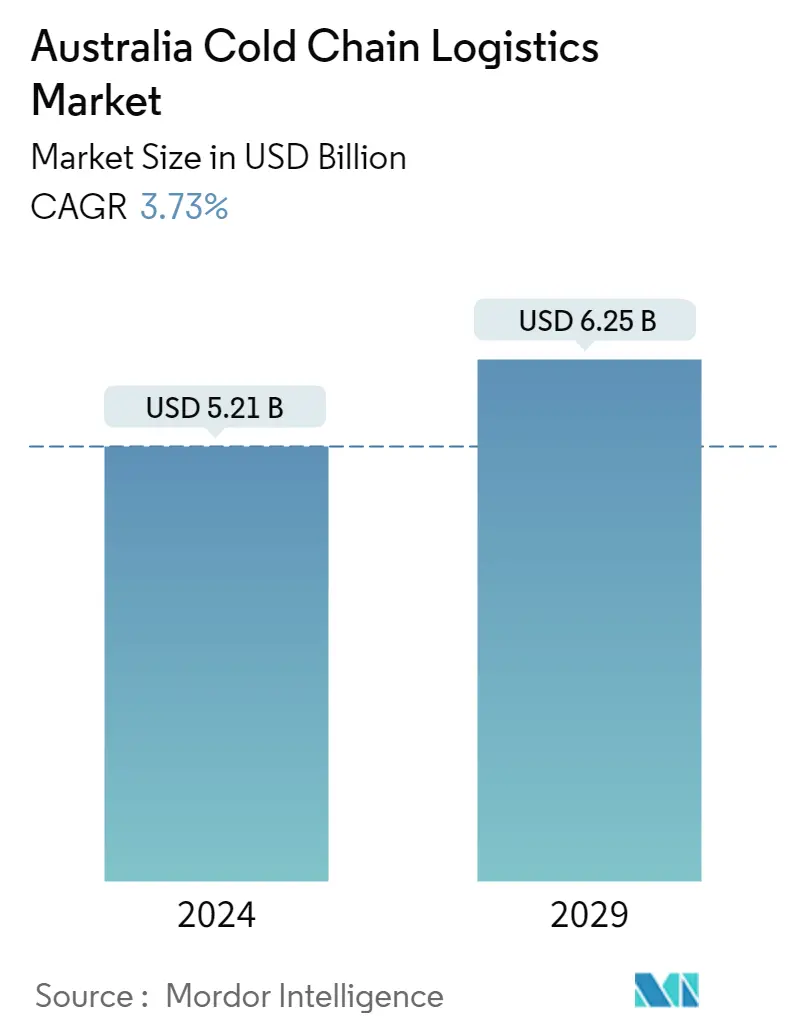Market Size of Australia Cold Chain Logistics Industry

| Study Period | 2020 - 2029 |
| Base Year For Estimation | 2023 |
| Market Size (2024) | USD 5.21 Billion |
| Market Size (2029) | USD 6.25 Billion |
| CAGR (2024 - 2029) | 3.73 % |
| Market Concentration | Low |
Major Players
*Disclaimer: Major Players sorted in no particular order |
Cold Chain Logistics Australia Market Analysis
The Australia Cold Chain Logistics Market size is estimated at USD 5.21 billion in 2024, and is expected to reach USD 6.25 billion by 2029, growing at a CAGR of 3.73% during the forecast period (2024-2029).
- The Australian cold chain logistics market was severely impacted by the pandemic. Not only did the abrupt closure of Australia's borders and subsequent closure of passenger routes result in a halt in human movement, but it also impacted transport cargo capacity in and out of Australia. The previous routes were no longer as easily accessible for businesses looking to move goods in and out of the country, and prices for the limited opportunities available were at a premium. Australia is a major player in the production and export of perishable goods, with the largest share of the country's cold chain logistics market.
- According to the data from the Australian Bureau of Statistics, more than a third of all businesses (37%) experienced supply chain disruptions in February 2022. This latest data shows that supply chain issues had decreased since January, when nearly half of all businesses (47%) reported having them, but have remained elevated since the survey was last collected in April 2021. According to the report, the most common supply chain issue facing businesses is domestic and international delivery delays (88%), followed by supply constraints (80%) and price increases (75%).
- Every year, 7.6 million tonnes of food are wasted in Australia, costing USD 37 billion, with flaws in the cold chain playing a significant role. Food demand will increase by 50% over the next ten years, while energy demand will increase by 50%, and water demand will increase by 30%. The National Construction Code (NCC) specifies insulation for everything, and there is no standard or regulation for insulation in the cold chain followed. One area where Australia falls far short is in necessities such as standardized truck widths and pallet sizes. The rest of the world uses 2.6-meter pallets, while Australians use 2.5-meter pallets, which causes overloading, reduced airflow, and other issues.
- Despite the rising challenges in the market, cold chain logistics is experiencing growth in Australia due to the surge in demand for food products, meat, pharmaceuticals, and other goods which require temperature requirement and end-to-end delivery. Furthermore, there is growth in the market because of the supply of vaccines which require temperature controlled environment until it is administered to the citizens.
- One more trend in the market is the growth of e-commerce in the sector; this has created opportunities for wholesalers and retailers to deliver their products directly to customers. Many products which are sold through e-commerce distribution channels require cold chain logistics, and the ease of product availability has propelled the logistics partners to provide facilities for the smooth movement of these products to the consumers without any damage. These trends, along with some others, are expected to drive the market in the forecast period despite the challenges rising in the industry.
Cold Chain Logistics Australia Industry Segmentation
A cold chain is a temperature-controlled supply chain. Cold chain logistics is the technology and process that allows the safe transport of temperature-sensitive goods and products along the supply chain. A complete background analysis of the Australia Cold Chain Logistics Market, including the assessment of the economy and contribution of sectors in the economy, market overview, market size estimation for key segments, and emerging trends in the market segments, market dynamics, and geographical trends, and COVID-19 impact is included in the report.
The Australia cold chain logistics market is segmented by service (storage, transportation, and value-added services), temperature type (chilled and frozen), and application (fruits and vegetables, dairy products, meat and seafood, processed food, pharmaceuticals (include biopharma), bakery and confectionery, and other applications). The report offers market sizes and forecasts in values (USD billion) for all the above segments.
| By Services | |
| Storage | |
| Transportation | |
| Value-added Services (Blast Freezing, Labeling, Inventory Management, etc.) |
| By Temperature Type | |
| Chilled | |
| Frozen |
| By Application | |
| Fruits & Vegetables | |
| Dairy Products | |
| Meat and Seafood | |
| Processed Food | |
| Pharmaceuticals (Include Biopharma) | |
| Bakery and Confectionery | |
| Other Applications |
Australia Cold Chain Logistics Market Size Summary
The Australian cold chain logistics market is poised for growth, driven by the increasing demand for temperature-sensitive goods such as food, pharmaceuticals, and vaccines. Despite the challenges posed by the pandemic, which disrupted supply chains and increased costs, the market is expected to expand steadily over the forecast period. The sector plays a crucial role in supporting Australia's significant export of perishable goods, although it faces issues like supply chain disruptions, delivery delays, and regulatory inconsistencies. The rise of e-commerce has further fueled the demand for efficient cold chain logistics, as more consumers seek the convenience of online shopping for perishable items. This trend presents both challenges and opportunities for logistics providers to enhance their services and infrastructure.
The market landscape is characterized by a fragmented structure with numerous local players, such as Americold, Newcold Advanced Cold Logistics, and Auscold Logistics PTY Ltd., dominating the scene. These companies are investing in advanced facilities and technologies to meet the growing demands of the sector. International players are also exploring entry into the market, although they face challenges due to the stronghold of local companies and existing market conditions. Innovations in logistics solutions, such as vacuum-insulated shippers, are being introduced to improve efficiency and maintain product integrity over longer distances. As the market continues to evolve, it is expected to offer substantial opportunities for both local and international players to capitalize on the increasing need for reliable cold chain logistics in Australia.
Australia Cold Chain Logistics Market Size - Table of Contents
-
1. MARKET INSIGHTS AND DYNAMICS
-
1.1 Current Market Scenario
-
1.2 Market Overview
-
1.3 Market Dynamics
-
1.3.1 Drivers
-
1.3.2 Restraints
-
1.3.3 Opportunities
-
-
1.4 Value Chain / Supply Chain Analysis
-
1.5 Industry Attaractiveness - Porter's Five Forces Analysis
-
1.5.1 Threat of New Entrants
-
1.5.2 Bargaining Power of Buyers/Consumers
-
1.5.3 Bargaining Power of Suppliers
-
1.5.4 Threat of Substitute Products
-
1.5.5 Intensity of Competitive Rivalry
-
-
1.6 Technological Trends and Automation
-
1.7 Government Regulations and Initiatives
-
1.8 Industry Value Chain/Supply Chain Analysis
-
1.9 Spotlight on Ambient/Temperature-controlled Storage
-
1.10 Impact of Emission Standards and Regulations on Cold Chain Industry
-
1.11 Impact of COVID-19 on the Market
-
-
2. MARKET SEGMENTATION
-
2.1 By Services
-
2.1.1 Storage
-
2.1.2 Transportation
-
2.1.3 Value-added Services (Blast Freezing, Labeling, Inventory Management, etc.)
-
-
2.2 By Temperature Type
-
2.2.1 Chilled
-
2.2.2 Frozen
-
-
2.3 By Application
-
2.3.1 Fruits & Vegetables
-
2.3.2 Dairy Products
-
2.3.3 Meat and Seafood
-
2.3.4 Processed Food
-
2.3.5 Pharmaceuticals (Include Biopharma)
-
2.3.6 Bakery and Confectionery
-
2.3.7 Other Applications
-
-
Australia Cold Chain Logistics Market Size FAQs
How big is the Australia Cold Chain Logistics Market?
The Australia Cold Chain Logistics Market size is expected to reach USD 5.21 billion in 2024 and grow at a CAGR of 3.73% to reach USD 6.25 billion by 2029.
What is the current Australia Cold Chain Logistics Market size?
In 2024, the Australia Cold Chain Logistics Market size is expected to reach USD 5.21 billion.

